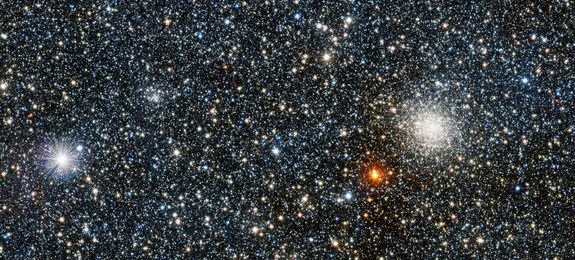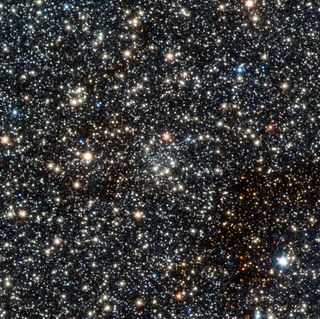European Telescope Discovers Rare Ancient Star Clusters

A European survey telescope has discovered two clusters of very old stars in our Milky Way, adding to the growing known number of these relatively rare cosmic objects.
Globular clusters are collections of 100,000 or more ancient stars. They are among the oldest objects in the universe, with some dating back to the formation of the Milky Way galaxy. Just 158 globular clusters were known to be in the Milky Way until the European Southern Observatory's VISTA survey telescope, at the Paranal Observatory in Chile, located two faint new ones, called VVV CL001 and VVV CL002.
The clusters were found in new images from the VISTA telescope that were part of the Vista Variables in the Via Lactea survey. The productive VVV survey also has located the first star cluster far beyond the center of the Milky Way; its light had to travel through the thick curtains of dust and gas at the heart of our galaxy to reach ground-based telescopes. [See video and photos of ancient star clusters]
In this new infrared image from VISTA, the dazzling UKS 1 globular cluster dominates on the right. But a surprise was found lurking in this rich star field: a much fainter cluster was discovered by sifting through the data from one of VISTA's surveys. This newly discovered globular cluster, VVV CL001, is a bit tricky to spot, but the small collection of stars is located in the left half of the image.

VISTA's observations turned out to be a boon for astronomers, because VVV CL001 was just the first of the telescope's globular discoveries. The same team of astronomers located a second unsuspected object, called VVV CL002, which appears in another of VISTA's infrared images.
VVV CL002 is a small, faint group of stars that may be the closest known globular cluster to the center of the Milky Way, officials from the European Southern Observatory said in a statement.
Since interstellar dust absorbs and reddens starlight, globular clusters can be seen only in infrared light, but this newly found pair is quite faint, which explains why they have been hidden for so long. Up until a few years ago, the UKS 1 cluster, which was discovered in 1980, was the dimmest known globular cluster in the Milky Way. However, it easily outshines those found by VISTA.
Sign up for the Live Science daily newsletter now
Get the world’s most fascinating discoveries delivered straight to your inbox.
Astronomers have suggested that VVV CL001 is gravitationally tied to UKS 1, which could make these two objects the Milky Way's first binary globular cluster pair, ESO officials said. But this could simply be an effect of the telescope's line of sight, which could be distorting the true distance between the clusters.
Despite VISTA's bounty, discoveries of new globular clusters in our Milky Way galaxy are very rare. Before the two new discoveries by VISTA, astronomers last discovered a new cluster in 2010.
Another newly announced cluster, VVV CL003, appears to be an open star cluster that lies about 15,000 light-years beyond the center of the Milky Way. This is the first such cluster to be discovered on the far side of our galaxy, ESO officials said.
The discovery of two new globular clusters comes early in the Vista Variables in the Via Lactea survey, which is systematically studying the central regions of the Milky Way in infrared light.
This story was provided by SPACE.com, sister site to LiveScience. Follow SPACE.com for the latest in space science and exploration news on Twitter @Spacedotcom and on Facebook.












